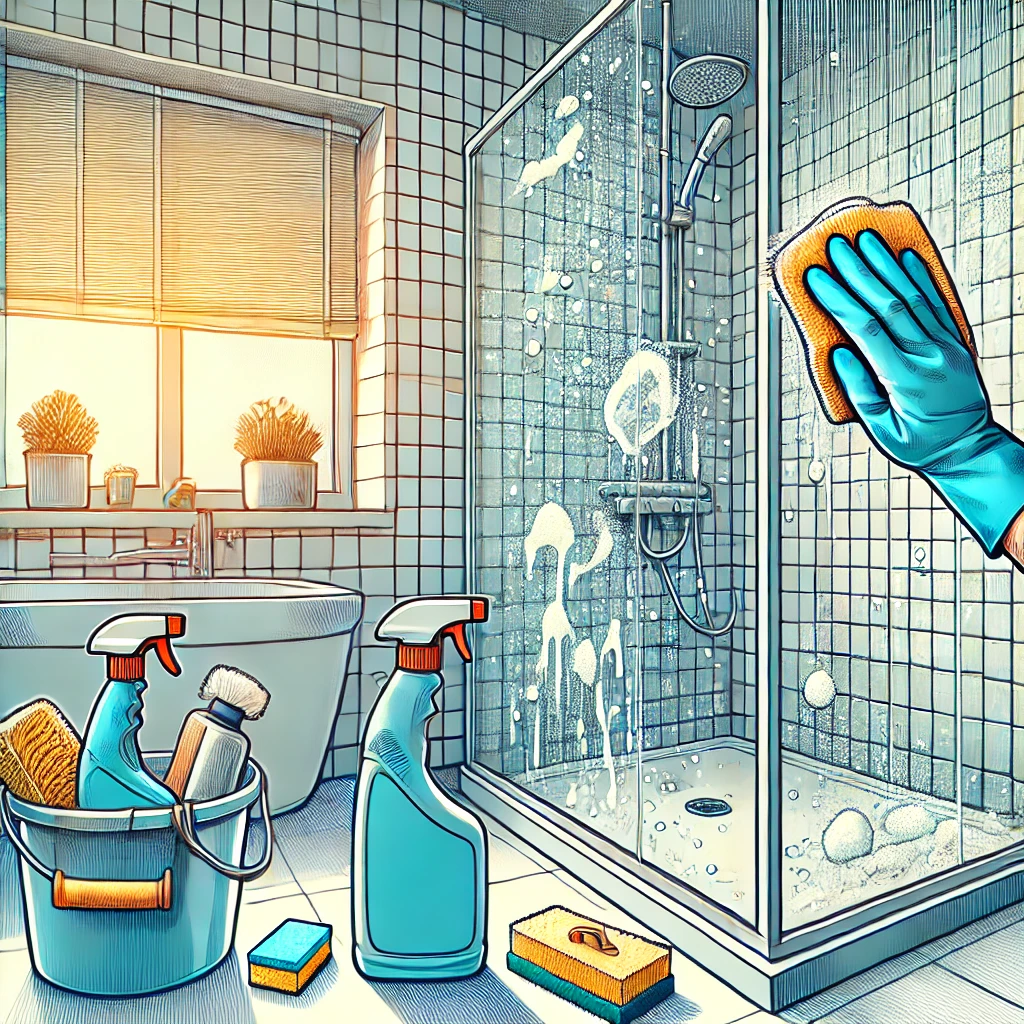
A clean shower is more than just a visually appealing part of your home it’s essential for maintaining hygiene and a healthy living environment. Showers are places of daily rejuvenation, but they can also become breeding grounds for unpleasant soap scum and potentially harmful mold if not properly maintained.
Soap scum is a chalky, white residue that forms when soap combines with hard water minerals, clinging to shower tiles, glass, and fixtures. Over time, it creates a stubborn layer that dulls the sparkle of your shower. On the other hand, mold thrives in the warm, damp conditions of your bathroom, often appearing as unsightly black or green patches in grout lines, corners, and on silicone seals. Beyond its unattractive appearance, mold can pose serious health risks, especially for individuals with allergies or respiratory issues.
The combination of soap scum and mold makes shower cleaning a persistent challenge for many homeowners. Left unaddressed, these issues can lead to permanent staining, foul odors, and even damage to bathroom surfaces.
Fortunately, removing soap scum and mold doesn’t require harsh chemicals or endless scrubbing. With the right approach, tools, and techniques, you can restore your shower to a spotless and healthy condition. This guide provides a step-by-step process, incorporating natural remedies, effective cleaning products, and preventive measures to tackle these issues efficiently. By following these methods, you’ll not only clean your shower but also ensure it stays fresh and mold-free for longer.
Understanding Soap Scum and Mold
Soap scum and mold are two of the most common culprits behind an unclean shower, but understanding their nature can help you tackle them effectively.
What is Soap Scum?
Soap scum is the result of a chemical reaction between soap and the minerals found in hard water, such as calcium and magnesium. This reaction creates a filmy residue that clings to shower tiles, glass, and metal fixtures. Over time, soap scum hardens into a stubborn, chalky white or gray layer that dulls surfaces and attracts dirt and grime. It often appears on shower doors, walls, and faucets, creating a buildup that’s both unsightly and tough to remove.
What is Mold?
Mold is a type of fungus that thrives in moist, warm environments, making your shower an ideal breeding ground. It often appears as black, green, or even pink patches, commonly found in grout lines, corners, and silicone seals. Mold spreads quickly if not addressed, feeding on organic matter like soap residue and the microscopic particles of skin cells left behind during showering.
The Health and Aesthetic Impacts
Leaving soap scum and mold untreated can have significant consequences. While soap scum is primarily an aesthetic issue, it creates a sticky surface that can harbor bacteria and grime. Mold, on the other hand, is more than just an eyesore—it can release spores into the air, potentially triggering allergic reactions, respiratory issues, and other health problems. Prolonged exposure to mold can be especially harmful to individuals with asthma or weakened immune systems.
Beyond health risks, these contaminants diminish the appearance of your shower, making it look neglected and unhygienic. If left unchecked, mold can even cause permanent staining and damage to grout and tiles, leading to costly repairs.
Tools and Materials Needed
Before diving into the cleaning process, it’s essential to gather the right tools and materials to ensure effective and efficient cleaning.
Natural Cleaning Agents
- Vinegar: A powerful natural cleaner that dissolves soap scum and kills mold due to its acidic properties.
- Baking Soda: A gentle abrasive that works well for scrubbing surfaces and neutralizing odors.
- Lemon Juice: A natural bleaching agent that helps break down soap scum and leaves a fresh scent.
Commercial Cleaning Products
If you prefer ready-made solutions, there are numerous commercial products designed specifically for removing soap scum and mold. Look for those labeled as safe for bathroom surfaces and effective against mold and mildew.
Essential Tools
- Scrub Brushes: Stiff-bristled brushes for grout lines and tougher stains.
- Microfiber Cloths: Soft and absorbent cloths for wiping down surfaces.
- Sponges: For general cleaning and applying cleaning solutions.
- Gloves: To protect your hands from cleaning agents and potential mold exposure.
- Spray Bottles: For applying natural or commercial cleaning solutions evenly.
With these tools and materials on hand, you’ll be well-equipped to tackle the soap scum and mold in your shower, restoring its cleanliness and ensuring a healthier environment.
Step-by-Step Guide to Remove Soap Scum
1. Preparing the Area: Ventilation and Clearing the Shower
Start by ensuring proper ventilation in your bathroom. Open windows or turn on the exhaust fan to prevent fumes from building up, especially if you’re using commercial cleaners. Remove all items from the shower, including shampoo bottles, soap dishes, and loofahs, to give you full access to all surfaces.
2. Using Natural Cleaners: Vinegar and Baking Soda Solution
Natural cleaners are effective and eco-friendly options for tackling soap scum:
- Vinegar Spray: Mix equal parts of white vinegar and warm water in a spray bottle. Spray the solution generously onto soap-scum-covered surfaces, ensuring complete coverage. Let it sit for 10–15 minutes to break down the residue.
- Baking Soda Scrub: For tougher spots, sprinkle baking soda directly onto a damp sponge or microfiber cloth. Scrub the affected areas in circular motions to loosen and remove the buildup.
3. Commercial Product Application: How to Use Effectively
If natural cleaners aren’t enough, a commercial soap scum remover can help:
- Choose a product labeled for use on the type of surface you’re cleaning (e.g., tile, glass, or metal).
- Spray or apply the cleaner as directed on the label, focusing on areas with heavy buildup. Allow it to sit for the recommended time.
- Use a scrub brush or sponge to agitate and remove the softened residue.
4. Scrubbing and Rinsing: Techniques for Best Results
- Use a stiff-bristled scrub brush for grout lines and textured surfaces, while a softer sponge works well for glass and smooth tiles.
- Rinse thoroughly with warm water, ensuring no cleaner residue is left behind. Dry the surfaces with a microfiber cloth to prevent new spots from forming.
Step-by-Step Guide to Remove Mold
1. Safety Precautions: Protective Gear and Ventilation
Mold can release harmful spores during cleaning, so take safety seriously:
- Wear gloves, a mask, and goggles to protect your skin, lungs, and eyes.
- Ensure good ventilation by opening windows or using a fan.
2. Natural Remedies: Hydrogen Peroxide, Tea Tree Oil, or Baking Soda Paste
- Hydrogen Peroxide: Pour 3% hydrogen peroxide into a spray bottle and apply it directly to the moldy areas. Let it sit for 10 minutes before scrubbing with a brush.
- Tea Tree Oil: Mix 1 teaspoon of tea tree oil with 1 cup of water in a spray bottle. Spray the solution onto moldy spots, let it sit, and wipe clean without rinsing for lasting effects.
- Baking Soda Paste: Combine baking soda and water into a thick paste. Apply it to the mold, scrub with a brush, and rinse with water.
3. Using Mold-Specific Cleaners: Instructions for Application
For persistent mold, commercial mold and mildew cleaners can be highly effective:
- Apply the product as directed, focusing on heavily infested areas.
- Allow the cleaner to penetrate the mold for the recommended time before scrubbing and rinsing thoroughly.
4. Preventing Mold Regrowth: Tips and Habits to Maintain a Dry Shower
- Wipe down shower walls and doors with a squeegee or towel after each use.
- Ensure adequate ventilation by running the exhaust fan during and after showers.
- Keep the bathroom door open to reduce humidity levels.
- Consider applying a mold-resistant spray or sealant to grout lines and corners.
Preventing Soap Scum and Mold Build-Up
Once you’ve removed soap scum and mold, adopting preventive measures can help keep your shower looking pristine while reducing the effort required for future cleaning. Prevention is key to maintaining a clean and healthy bathroom environment.
1. Daily Practices: Squeegeeing and Wiping Down Surfaces
One of the simplest ways to prevent soap scum and mold is by maintaining a dry shower after each use:
- Squeegee After Showers: Use a squeegee to remove water from walls, doors, and tiles. This simple action reduces moisture, which helps prevent both soap scum and mold.
- Wipe Down Surfaces: Use a microfiber cloth or towel to dry faucets, handles, and other fixtures. Regularly removing water droplets minimizes soap scum buildup and prevents mold spores from thriving.
2. Weekly Cleaning Routine: Simple Tasks to Maintain Cleanliness
Incorporating a quick weekly cleaning routine can significantly reduce the chances of soap scum and mold accumulating:
- Light Scrubbing: Use a mild cleaner or a mixture of vinegar and water to wipe down tiles, grout, and glass. Focus on areas prone to buildup, such as corners and shower doors.
- Inspect for Mold: Check grout lines, silicone seals, and less visible areas for early signs of mold. Address any spots immediately to stop the spread.
- Clean Drains: Ensure the drain remains unclogged to avoid standing water, which encourages mold growth.
3. Using Preventive Products: Water Repellents and Mold-Resistant Sprays
- Water Repellents: Apply a water-repellent product to glass doors and tiles to create a barrier that prevents water, soap residue, and minerals from sticking. These products make surfaces easier to clean and help maintain a sparkling finish.
- Mold-Resistant Sprays: Use a mold-preventive spray on grout, tiles, and seals. These sprays often contain anti-fungal agents that inhibit mold growth.
- Switch to Liquid Soap or Body Wash: Unlike bar soap, liquid soap doesn’t leave behind the fatty acids that contribute to soap scum. Switching can reduce buildup over time.
By integrating these preventive practices into your daily and weekly routines, you can significantly minimize the recurrence of soap scum and mold. Not only will this save time and effort, but it will also ensure your shower remains a clean, healthy space for relaxation and rejuvenation.
Read more: How to remove soap scum and hard water deposits
Conclusion
Maintaining a clean and mold-free shower is essential for both aesthetic and health reasons. Soap scum and mold not only create an unsightly appearance but can also pose risks to your health if left untreated. Fortunately, with the right tools, cleaning solutions, and preventive measures, you can easily manage these common issues.
By understanding the nature of soap scum and mold, you can choose the best cleaning methods and products that suit your preferences—whether natural remedies like vinegar and baking soda or commercial cleaners. Taking the time to follow a regular cleaning routine and incorporating simple daily practices, like squeegeeing and wiping down surfaces, can significantly reduce the effort needed for future cleanings.
Furthermore, using water-repellent products and mold-resistant sprays will go a long way in preventing the buildup of soap scum and the growth of mold, ensuring that your shower remains fresh, clean, and safe.
